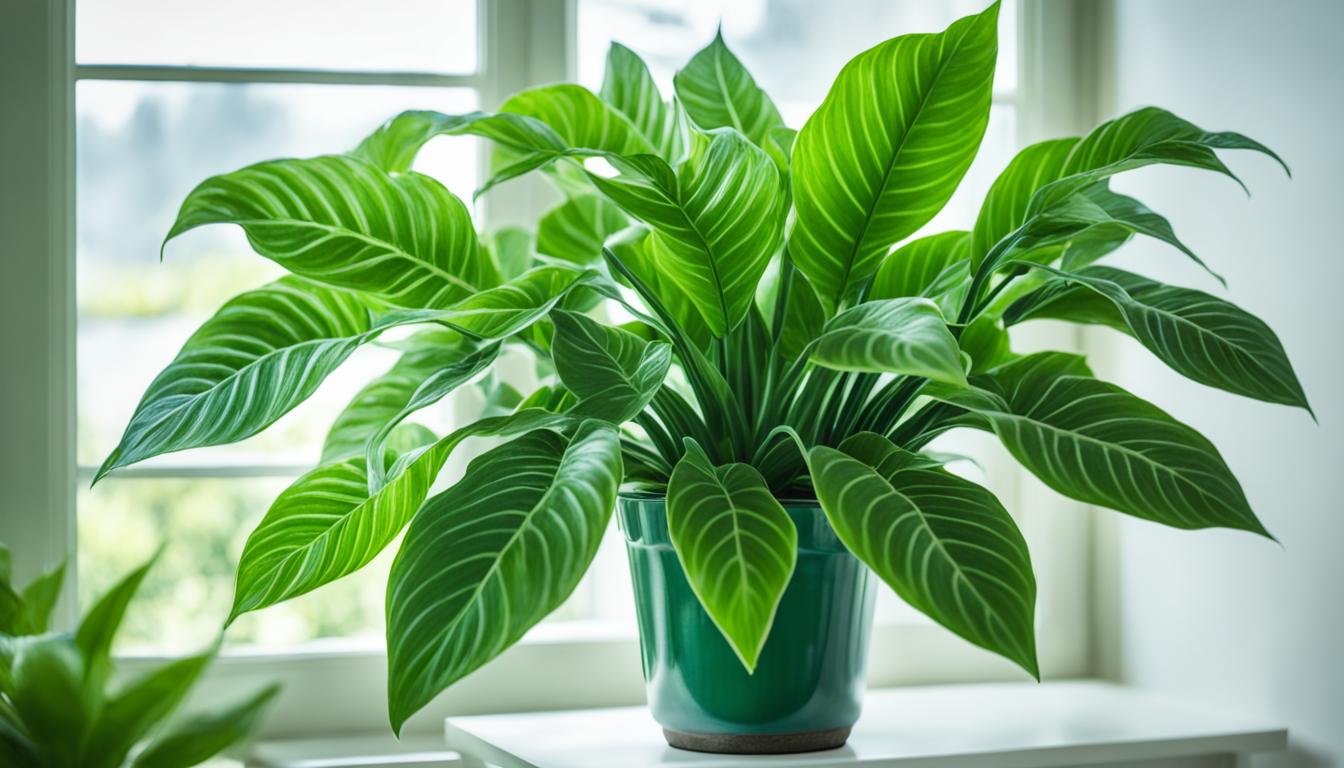Did you know indoor plants make the air better? They also make your home feel nicer. Having plants inside can make you less stressed and more productive. If you need an easy-to-care-for plant, the cast iron plant is great.
The cast iron plant is also called Aspidistra elatior. It’s tough and can grow well inside. It doesn’t need much light and is okay if you forget it sometimes. This guide will help you know how to take care of a cast iron plant in your home.
Key Takeaways:
- Indoor plants, like the cast iron plant, help clean the air and make you happier.
- The cast iron plant doesn’t need much work. It’s good for people living in apartments.
- This guide tells you everything to grow and look after a cast iron plant inside.
Why Do We Love the Cast Iron Plant For Apartments?
The cast iron plant is great for apartments. It fits well whether you know plants or are just starting. It becomes a lovely part of your home. Let’s see why many people like it for their places.
Is the Cast Iron Plant Air-Purifying?
This plant cleans the air. It gets rid of bad stuff like formaldehyde, benzene, and xylene. With lots of leaves, it makes your apartment’s air better.
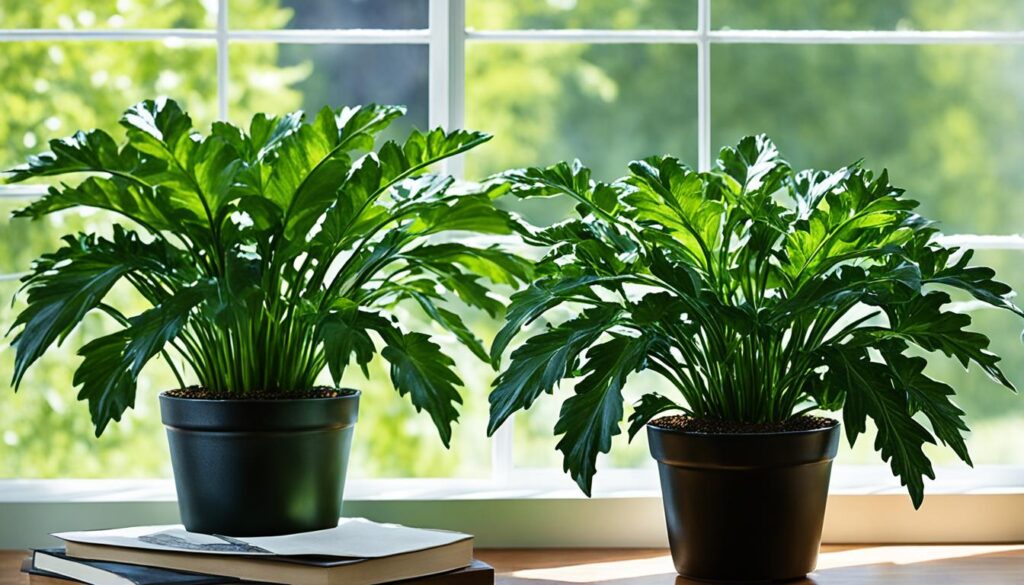
Is the Cast Iron Plant Pet Friendly?
Pet owners will love that this plant is safe. It’s okay around dogs, cats, and kids. This means no worry with the cast iron plant around.
How Big Does the Cast Iron Plant Get?
It’s a small plant, perfect for tiny places. It grows to about 2 to 3 feet tall and 1 to 2 feet wide. So, it’s easy to keep in your apartment.
This plant is popular for good reasons. It cleans the air, is safe for pets, and doesn’t need much space. It makes your home look nice and feel healthier.
How to Grow a Cast Iron Plant – Learn to Grow this Indoor Beauty
Growing a cast iron plant indoors is simple. This guide will show you how. You’ll learn about the right pot, soil, light, and how to water it. We’ll also cover feeding, trimming, and keeping it healthy. Plus, tips on making more plants and dealing with pests.
Choosing the Right Pot and Soil
Choosing a good pot and soil is key. Use a pot that drains well and is big enough. It should have holes to stop water from sitting. For soil, pick a mix that drains well but holds some moisture. It should also have lots of organic stuff for the best growth.
Providing Adequate Light
Cast iron plants don’t need much light. They do well in spots with low or medium light. Put them near a window that doesn’t get direct sun. Like one that faces north. If needed, a regular house light can work too.
Watering and Humidity
Watering right is important for your plant. Water it when the top soil is dry. Make sure the extra water can drain out. Don’t water it too much to avoid wet roots. For humidity, they’re happy with what most homes have. If your place is dry, a humidifier can help. Or try a water tray with rocks underneath.
Nutrition and Fertilization
Feeding your plant helps it grow better. Use a balanced fertilizer that works for indoor plants. Follow what the label says for how much and when. Feed it in the growing months, like spring and summer.
Pruning and Maintenance
Keeping your plant trimmed makes it look nice. Cut off any leaves that are yellow or brown. And trim back parts that are too long or crowded. This helps it grow new parts. You might need to change its pot every few years to give it more space.
Propagation
Making new plants is fun. You can split a healthy part into new pots. Or use pieces of the root in moist soil to start new ones. Do this in the spring or early summer for the best results.
Monitoring for Pests and Diseases
Even though cast iron plants are tough, watch for bugs and sickness. Look out for spider mites, tiny bugs, and scale insects. Check your plant and act fast if you see these pests. Also, keep an eye out for rotten roots or spotted leaves. Fix any problems right away.
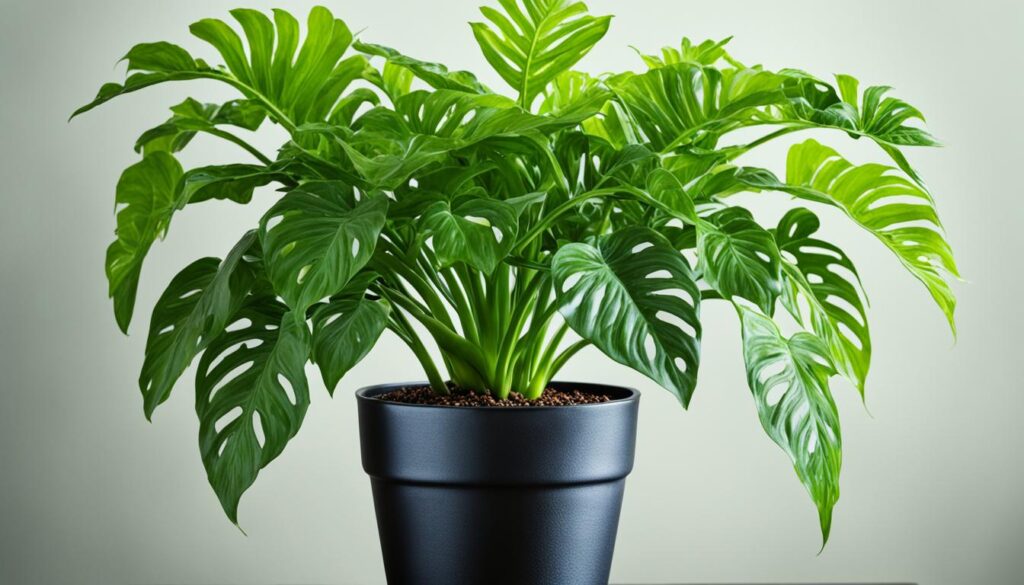
Appearance of Cast Iron Plant
The cast iron plant looks great and stands out. It’s a favorite for indoor spaces. Its leaves bend nicely, giving beauty to any area.
This plant’s leaves are a deep green. This makes a room look lively and full. The leaves are big, about two feet long and four inches wide.
Some cast iron plants have cool patterns. You might see yellow spots or light stripes. This adds more beauty.
The plant has lots of leaves that make it look full. Its thick greenery makes it perfect for adding life indoors.
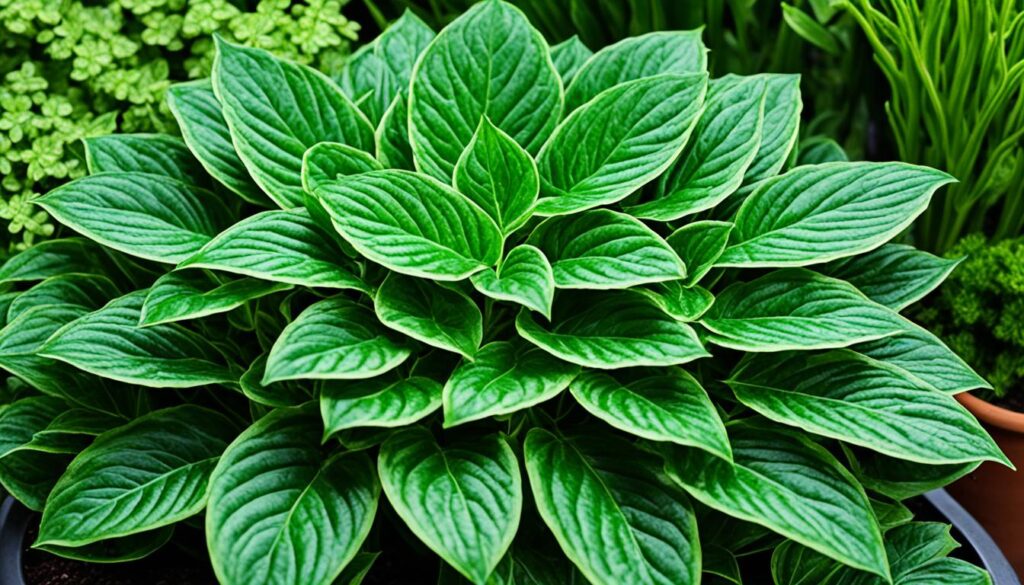
Light Requirements for Cast Iron Plant
The cast iron plant is a great indoor plant. It does well in many light conditions. It’s important to get the light right for your plant to be healthy and grow.
To make your cast iron plant happy, it needs not too much and not too little light. These plants like places that don’t get a lot of natural light. This makes them perfect for darker rooms in your home or apartment.
You shouldn’t put the plant in direct sunlight. That’s too harsh for it. Instead, it’s best in indirect light, like near a window that doesn’t face south.
Cast iron plants can get used to different kinds of light. Watch how your plant reacts to the light it gets. Then, you can change its spot if needed to keep it doing well.
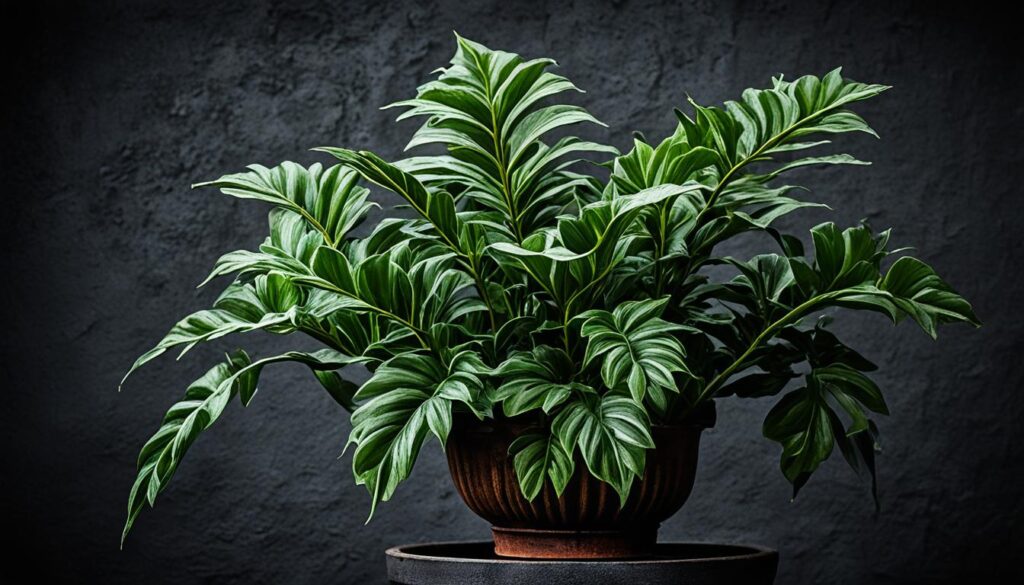
Right light balance is key for a healthy cast iron plant. With the correct light, it will look beautiful. It will stay a low-care part of your indoor garden.
Watering Requirements of the Cast Iron Plant
Watering right keeps your cast iron plant healthy and growing well. It’s key to not let water issues hurt it.
Finding a balance is key. Too much or too little water harms the plant. You must watch for signs and change how much you water as needed.
Signs of Overwatering
Too much water can cause root rot and more. Signs of too much water include:
- Yellowing or wilting leaves: Yellow or droopy leaves mean overwatering.
- Mold or fungus growth: Wetness invites mold or fungus. Watch for unusual spots on soil or leaves.
- Root rot: Bad smell and dark roots show too much water.
Signs of Underwatering
A cast iron plant needs enough water, or it will show signs. Here are signs it needs more:
- Wilting or drooping leaves: Dry and droopy leaves say it’s thirsty.
- Brittle or yellowing leaves: Leaves get dry or yellow without enough water.
- Slow growth: Not enough water means slow growth or no new leaves.
Check the soil’s wetness often. Push your finger in. If it’s dry, water your plant.
Fertilizing a Cast Iron Plant
Fertilizing is important for a cast iron plant’s health. It gives the plant vital nutrients for growth.
In this section, learn when and how to fertilize your plant. I’ll also mention the best fertilizer for its needs.
Recommended Fertilizer for a Cast Iron Plant
Choose a balanced, slow-release fertilizer for your plant. Look for a 10-10-10 or 20-20-20 mix. This mix offers the nutrients needed for growth.
Pick a slow-release type made for indoor plants. It gives nutrients over time. This way, there’s no risk of giving too much.
Osmocote Indoor & Outdoor Smart-Release Plant Food![]() is a good fertilizer. It releases nutrients for four months. Moreover, it has iron and other micronutrients for cast iron plants.
is a good fertilizer. It releases nutrients for four months. Moreover, it has iron and other micronutrients for cast iron plants.
Always use fertilizers as directed. Using too much can hurt your plant.
Fertilize mainly from spring to fall. Cut back in winter when growth slows.
Water the soil before fertilizing. This prevents root damage.
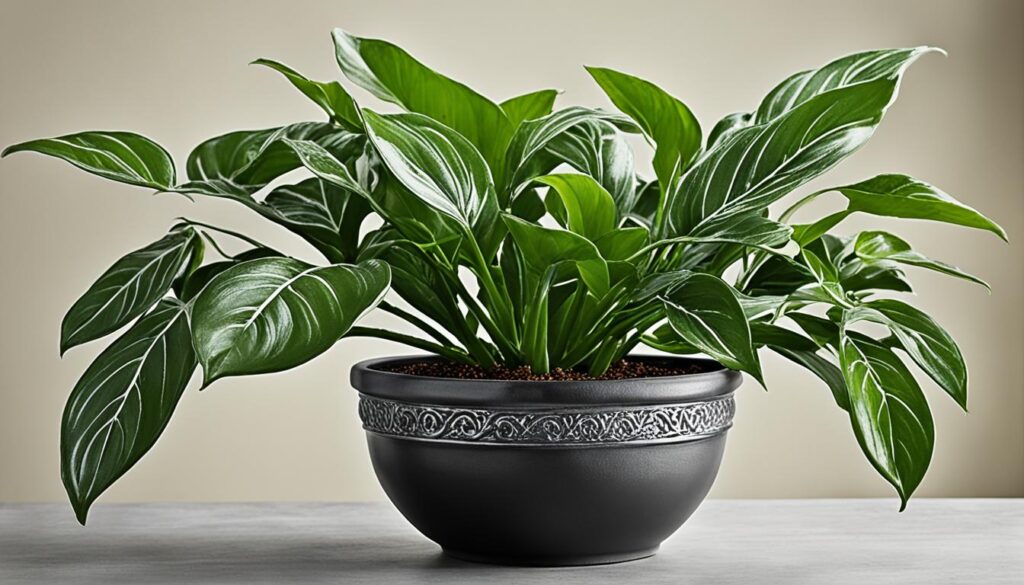
| Recommended Fertilizer | N-P-K Ratio | Release Time | Benefits |
|---|---|---|---|
| Osmocote Indoor & Outdoor Smart-Release Plant Food | 14-14-14 | Slow-release over 4 months | Provides essential macronutrients and micronutrients for healthy growth |
Potting a Cast Iron Plant
Proper potting helps a cast iron plant grow well. I’ll show you how to pot the plant right.
We will look at choosing the correct pot size, the right soil, and when to repot. Doing this will help your plant do its best in its new pot.
Choosing the Right Pot Size
It’s key to pick the right pot size for your plant. A small pot can stop growth. A big pot can make roots rot. Pick a pot that’s 2-4 inches wider than the plant’s current one. This size is just right for growth.
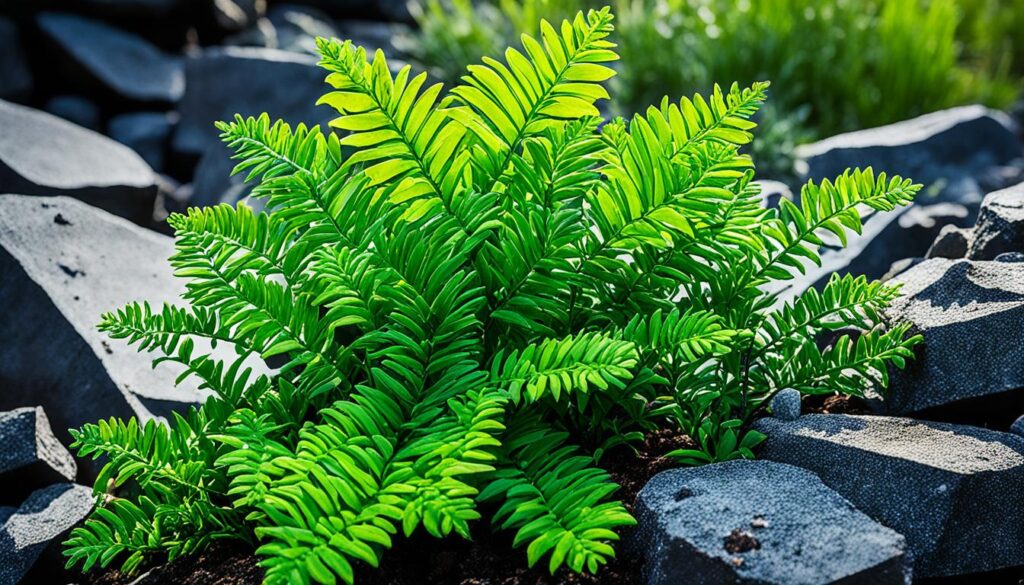
Using the Right Potting Mix for a Cast Iron Plant
The right soil mix is very important for the plant’s health. Go for a mix that drains well but holds some water. Mix peat moss, perlite, and sand for the soil. This combo drains well and keeps roots moist.
Repotting When Necessary
Sometimes, you must move your plant to a new pot. You’ll see roots outside the pot or the plant might stop growing. When repotting, take the plant out gently. Tease the roots and put it in a new pot with fresh soil. Always water your plant well after repotting.
Follow these steps for potting your cast iron plant. This way, your plant will grow well and look beautiful.
Propagating a Cast Iron Plant
Propagating a cast iron plant is a great way to grow your collection. You can share this plant with friends too. There are two ways to do it: stem cuttings and division. Both ways have good points. Let’s look at both to pick the best way for your plant.
Stem Cuttings Or Seeds?
Stem cuttings are easy and common for growing more plants. Here is how to do it:
- Find a healthy stem with a few leaves.
- Cut it right below a leaf node.
- Take off the lower leaves, leaving some on top.
- Put the cutting in wet potting mix or rooting powder.
- Keep it in a warm, moist place until it grows roots.
- After roots grow, move it to a new pot.
Using seeds is another way, but it takes longer. Here’s how to plant seeds:
- Get mature seeds from a healthy plant.
- Prepare a pot with good-draining soil.
- Put seeds on the soil and cover them lightly.
- Keep the soil wet and warm for the seeds to grow.
- When small plants grow a few leaves, put them in their pots.
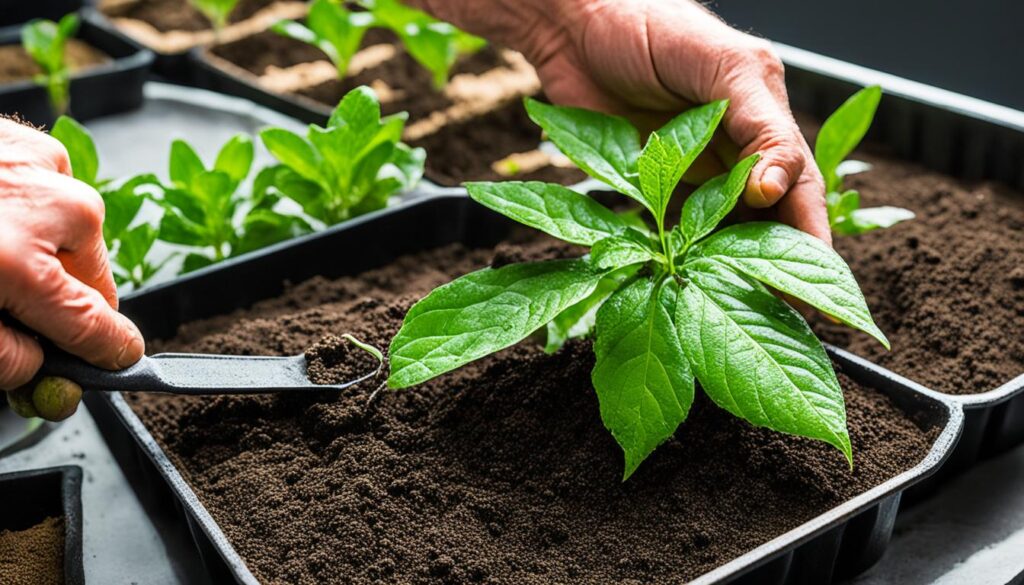
Division Of A Cast Iron Plant
Division is also good for making new plants. It splits a big plant into smaller ones.
- Pick a big, healthy plant.
- Take it out of its pot carefully.
- Split the plant into parts with good roots.
- Plant each part in a new pot with new soil.
- Water them well and take good care of them.
Spring is the best time for division. The plant grows new roots easier.
Choosing stem cuttings, seeds, or division is fun. It helps your plant collection grow. Share your plants with friends. Try different ways to see what’s best for you. Enjoy watching your cast iron plant get bigger and stronger.
Growth and Development of the Cast Iron Plant
It’s important to know how the cast iron plant grows to care for it well. This plant is special because it grows slowly and likes low light. This makes it perfect for places like apartments.
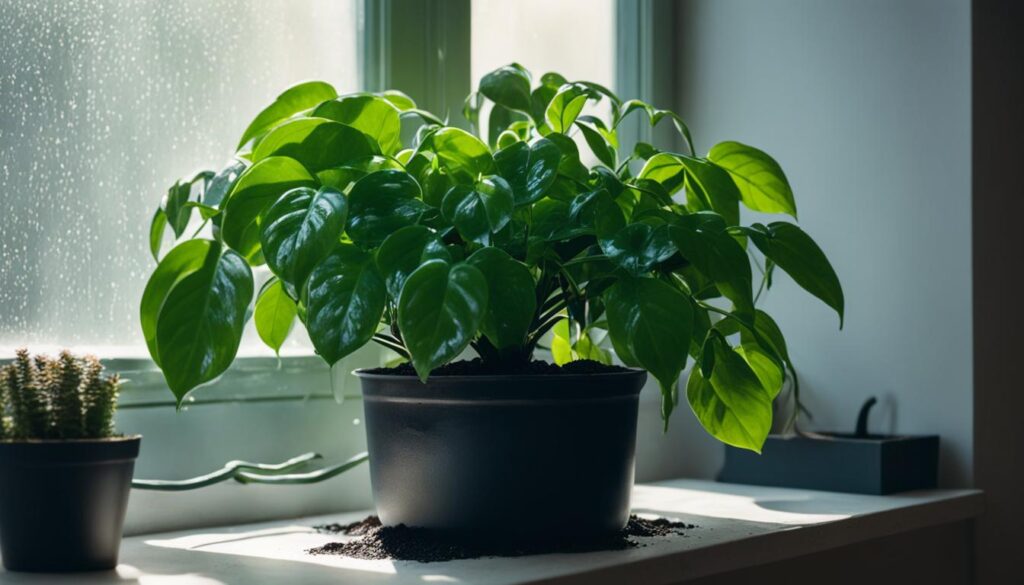
The cast iron plant usually grows 2 to 3 feet tall and 1 to 2 feet wide. It grows slowly, so you don’t need to cut it often. This makes it easy to keep.
At first, the cast iron plant starts as a seed or young plant. It needs some help to grow strong roots. After that, it grows thick leaves that are very tough.
This plant makes new leaves from its middle. These leaves turn green as they grow. They make the plant look full and green all the time.
Watching a cast iron plant grow is interesting. With the right care, this sturdy plant will look great inside.
Dealing with Pests and Diseases in the Cast Iron Plant
The cast iron plant is tough. But it can still get pests and diseases. It’s very important to watch for problems. This will keep the plant healthy for a long time.
We’ll talk about the pests and diseases that can happen. And how to find and fix them. We will also talk about how to stop these problems.
Common Pests
The cast iron plant usually doesn’t get many pests. But some bugs can still be harmful:
- Spider mites
- Scale insects
- Mealybugs
These pests can hurt the plant’s leaves and make it weak. Check your plant often for bugs and take steps if you find them.
Identification and Treatment
Look closely at the plant’s leaves, stems, and bottom for pests or damage. You might see webbing, small bumps, or a white cottony stuff.
If pests show up, you have a few ways to get rid of them:
- Manual Removal: For just a few pests, pick them off with a cotton swab and rubbing alcohol. This needs patience and care.
- Insecticidal Soap: You can use insecticidal soap as directed to fight off pests. It’s safe for the plant.
- Neem Oil: Neem oil is a natural option. Mix it as the tag says and apply to the sick areas.
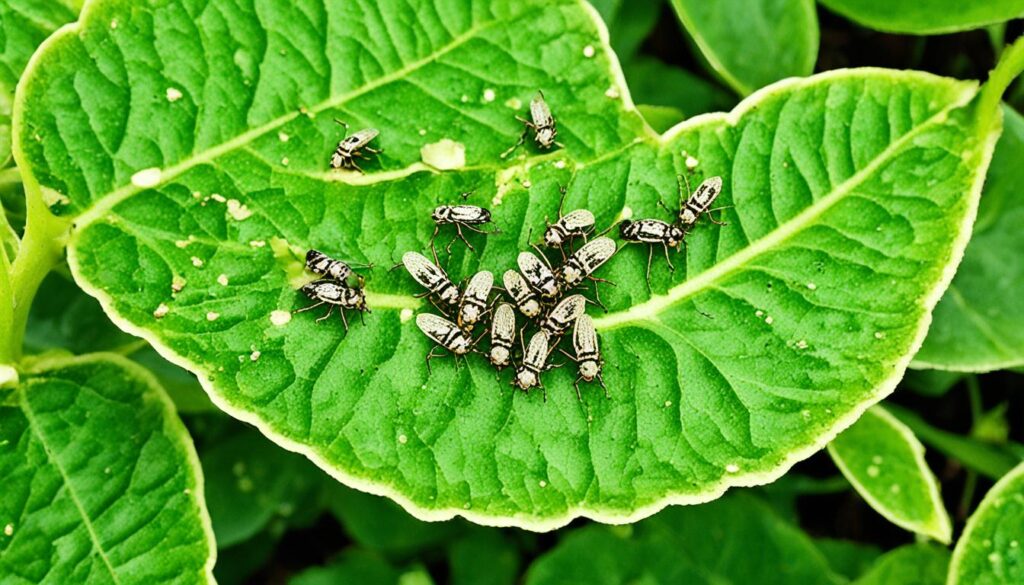
Preventive Measures
To stop pests, take these steps:
- Regular Inspection: Always look over your cast iron plant for pests. Finding them early can stop them from getting worse.
- Quarantine New Plants: Keep new plants away for a bit to make sure they don’t have pests. This keeps your cast iron plant safe.
- Maintain Good Air Circulation: Good air flow keeps pests away. Don’t put plants too close to each other.
- Manage Humidity: Pests like damp places. Keep the air just right by airing out the room and not overwatering.
By doing these things and fixing pest problems fast, you can have a healthy and happy cast iron plant.
Common Cast Iron Plant Pests
To keep your cast iron plant healthy, learn about pests. Understand how to identify, prevent, and treat them to protect your plant.
Some common pests that harm cast iron plants are:
- Scale: These tiny insects stick to leaves and stems. They eat the plant’s sap, causing yellow and wilted leaves.
- Mealybugs: Mealybugs are soft, white insects that clump together on the plant. They feed on the sap, leading to slower growth and discolored leaves.
- Spider Mites: Spider mites are little pests that create webs and eat leaf undersides. They make leaves have yellow spots, webbing, and fall off.
It’s key to spot these pests early. Check your plant often for yellow leaves, sticky stuff, or tiny bugs. If there’s an infestation, keep the sick plant away from healthy ones.
For getting rid of pests, try these methods:
- Natural Methods: Use a mix of water and insecticidal soap or neem oil. These natural solutions help fight off the pests.
- Chemical Treatments: For bad infestations, use chemical insecticides. Always use them as directed.
Always watch your cast iron plant for pests. Act fast to stop more damage. With the right care, your plant will keep looking lovely.
Natural Predators
Natural predators can help with pests in your cast iron plant. They are beneficial bugs and animals that control pest populations. This keeps your indoor garden healthy. Encouraging these allies reduces the need for chemicals. It makes your plant environment sustainable and green.
Isolate Infected Plants
If your cast iron plants get pests, keep them away from others. This stops pests from spreading. Separating sick plants helps protect your whole garden’s health.
Chemical Treatment
Sometimes, you might need chemicals to fight off big pest problems. If natural tricks don’t work, chemical treatments can help. But be careful when using them. Follow the instructions to keep your plants and yourself safe. Choose safe and green chemicals for your cast iron plant.
Disease Prevention For Cast Iron Plants
To keep your cast iron plant healthy, use disease prevention. Following simple tips will help your plant stay disease-free.
Sanitation is key. Clean your plant’s leaves regularly with a damp cloth. This removes dust and germs.
Give your plant the right light, water, and air. Don’t water too much. Too much water leads to disease. Keep the air and temperature right for your plant.
Watch your plant for signs of disease. Look for bad leaves or weird spots. If you see problems, fix them fast. Remove bad leaves or use treatments if needed.
Tips for Maintaining Cast Iron Plants
Cast iron plants need care for good growth. By following tips, your plant will do well indoors.
Wiping Leaves
It’s important to clean the leaves. Dust blocks sunlight and may bring bugs. Clean gently with a wet soft cloth. This makes the plant look nice and grow well. In addition to cleaning the leaves, regular pruning of dead or yellowing leaves can promote better growth and overall health for your plant. To ensure you’re providing the best environment for your spider plant, consider looking up some spider plant care tips that include proper watering and light conditions. A well-cared-for spider plant can produce offshoots, adding beauty and vitality to your space.
Outdoor Exposure
Sometimes, take your plant outside. Put it in shade for a few hours when the sun is weak. Being outside helps it get sunlight and stay healthy. But keep it safe from strong wind and too hot or cold weather.
Adjusting Watering Schedule
Water needs change with the seasons. When it’s hot, plants need more water. When cold, they need less. Check the soil to know when to water. This helps avoid too much or too little water, which is bad for the plant.
| Tip | Benefits |
|---|---|
| Regularly wipe the leaves | – Removes dust and dirt – Promotes better growth |
| Provide outdoor exposure | – Allows the plant to receive natural sunlight – Enhances overall health and vigor |
| Adjust watering schedule | – Prevents overwatering and underwatering – Ensures optimal moisture levels |
Tips for Successful Overwintering of Cast Iron Plant
Keeping your cast iron plant alive through winter is key. You must provide the right winter conditions. This will keep your plant healthy and bright. Here are some essential tips and guidelines for successful overwintering:
- Control Temperature: Keep your plant at a comfy 50-65°F (10-18°C). Avoid too cold or too hot spots.
- Adjust Light Exposure: In winter, these plants don’t need much light. Put your plant where it gets light but not directly.
- Monitor Soil Moisture: Make sure the soil isn’t too wet in winter. Only water when the soil’s top inch is dry. This prevents root rot.
- Reduce Fertilization: Fertilize less in winter because the plant grows slower. Use a weak fertilizer if you must.
- Avoid Drafts: Keep your plant away from cold air. Cold drafts can hurt the leaves.
- Clean and Inspect: Clean the plant well before bringing it inside. Look for pests or diseases. Fix them before the winter.
Follow these tips to help your cast iron plant get through winter strong. Make sure it has the right warmth, light, and water. With good care, your plant will grow well for many years.
Growing Cast Iron Plant from Seed
Growing a cast iron plant from seed is not common. But it’s exciting and rewarding. You can start new plants. And see the whole lifecycle of a cast iron plant. Here’s how to do it.
1. Seed Collection: Get ripe seeds from grown cast iron plants. Look for seed pods that are brown and starting to open.
2. Seed Preparation: Take out the seeds from the pods. Throw away any that look bad or off-color. Put the seeds in warm water for a day. This makes the seed coat soft and helps it grow.
3. Germination Techniques: There are two main ways to make cast iron plant seeds grow.
Method 1: Direct Sowing
- Get a seed tray or small pots ready with a potting mix that drains well.
- Sow the seeds about 1/4 inch deep. Cover them with a little soil.
- Keep the tray or pots in a place that’s warm and bright but not in full sun.
- Make sure the soil is a bit damp. Too much water can cause rot.
- Seedlings should pop up in 2-4 weeks. When they have real leaves, move them to bigger pots or outside.
Method 2: Cold Stratification
- Wrap the seeds in a wet paper towel. Or put them in a bag with damp peat moss.
- Close the towel or bag and put it in the fridge for 4-6 weeks. This fakes winter and helps seeds start growing.
- After that time, sow and care for them as in Method 1.
4. Caring for Young Seedlings: Once the seedlings are up, they need bright light but no direct sun. Keep them at a cozy temperature of 65-75°F (18-24°C). Water them when the top inch of soil is dry. Be careful not to give too much water.
5. Transplanting: When seedlings are a few inches tall and strong, move them. Put them in their own pots or outside. Use a potting mix that drains well. Make sure they have enough room to grow.
If you follow these steps, you can grow cast iron plants from seed. And you’ll love seeing your plant grow from the very start.
Varieties of Cast Iron Plant
Cast iron plants come in many forms. Each kind has unique features and looks. Apartment dwellers love them for adding green. One favorite type has leaves with cool patterns. These variegated leaves bring color and life to any room.
Some people like traditional plants better. They go for cast iron plants with dark green leaves. These plants look classic but still tough. Both variegated and solid green leaves fit any style you like. They make your home look great.
It’s important to know about different cast iron plants. Think about the light in your home and the look you want. Variegated or solid green, these plants are easy to care for. They stay strong and beautiful in your space.

